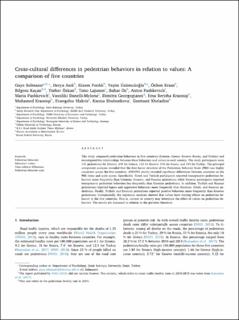| dc.contributor.author | Solmazer, Gaye | |
| dc.contributor.author | Azık, Derya | |
| dc.contributor.author | Fındık, Gizem | |
| dc.contributor.author | Üzümcüoğlu, Yeşim | |
| dc.contributor.author | Ersan, Özlem | |
| dc.contributor.author | Kaçan, Bilgesu | |
| dc.contributor.author | Özkan, Türker | |
| dc.contributor.author | Lajunen, Timo Juhani | |
| dc.contributor.author | Öz, Bahar | |
| dc.contributor.author | Pashkevich, Anton | |
| dc.contributor.author | Pashkevich, Maria | |
| dc.contributor.author | Danelli-Mylona, Vassiliki | |
| dc.contributor.author | Georgogianni, Dimitra | |
| dc.contributor.author | Berisha Krasniqi, Ema | |
| dc.contributor.author | Krasniqi, Muhamed | |
| dc.contributor.author | Makris, Evangelos | |
| dc.contributor.author | Shubenkova, Ksenia | |
| dc.contributor.author | Xheladini, Gentianë | |
| dc.date.accessioned | 2021-02-24T10:54:39Z | |
| dc.date.available | 2021-02-24T10:54:39Z | |
| dc.date.created | 2020-10-20T12:32:11Z | |
| dc.date.issued | 2020 | |
| dc.identifier.citation | Accident Analysis and Prevention. 2020, 138, . | en_US |
| dc.identifier.issn | 0001-4575 | |
| dc.identifier.uri | https://hdl.handle.net/11250/2730029 | |
| dc.description.abstract | This study compared pedestrian behaviors in five countries (Estonia, Greece, Kosovo, Russia, and Turkey) and investigated the relationships between these behaviors and values in each country. The study participants were 131 pedestrians for Estonia, 249 for Greece, 112 for Kosovo, 176 for Russia, and 145 for Turkey. The principal component analyses revealed that the four-factor structure of the Pedestrian Behavior Scale (PBS) was highly consistent across the five countries. ANCOVA results revealed significant differences between countries on the PBS items and scale scores. Specifically, Greek and Turkish participants reported transgressive pedestrian behaviors more frequently than Estonian, Kosovar, and Russian pedestrians while Kosovar participants reported transgressive pedestrian behaviors less frequently than Estonian pedestrians. In addition, Turkish and Russian pedestrians reported lapses and aggressive behaviors more frequently than Estonian, Greek, and Kosovar pedestrians. Finally, Turkish and Estonian pedestrians reported positive behaviors more frequently than Kosovar pedestrians. Unexpectedly, the regression analyses showed that values have varying effects on pedestrian behavior in the five countries. That is, context or country may determine the effect of values on pedestrian behaviors. The results are discussed in relation to the previous literature. | en_US |
| dc.language.iso | eng | en_US |
| dc.publisher | Elsevier | en_US |
| dc.rights | Attribution-NonCommercial-NoDerivatives 4.0 Internasjonal | * |
| dc.rights.uri | http://creativecommons.org/licenses/by-nc-nd/4.0/deed.no | * |
| dc.title | Cross-cultural differences in pedestrian behaviors in relation to values: A comparison of five countries | en_US |
| dc.type | Peer reviewed | en_US |
| dc.type | Journal article | en_US |
| dc.description.version | acceptedVersion | en_US |
| dc.source.volume | 138 | en_US |
| dc.source.journal | Accident Analysis and Prevention | en_US |
| dc.source.issue | 105459 | en_US |
| dc.identifier.doi | 10.1016/j.aap.2020.105459 | |
| dc.identifier.cristin | 1840854 | |
| dc.description.localcode | © 2020. This is the authors’ accepted and refereed manuscript to the article. Locked until 15 February 2023 due to copyright restrictions. This manuscript version is made available under the CC-BY-NC-ND 4.0 license http://creativecommons.org/licenses/by-nc-nd/4.0/ | en_US |
| dc.source.articlenumber | 105459 | en_US |
| cristin.ispublished | true | |
| cristin.fulltext | postprint | |
| cristin.qualitycode | 1 | |

